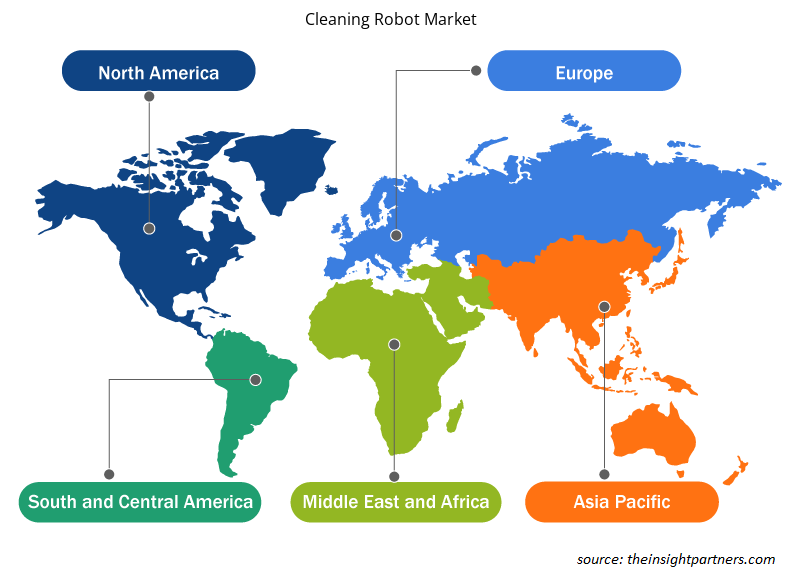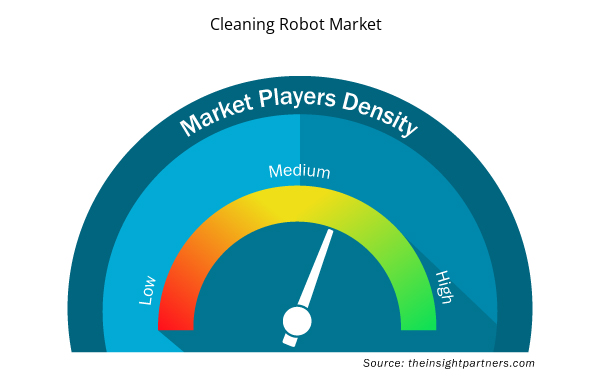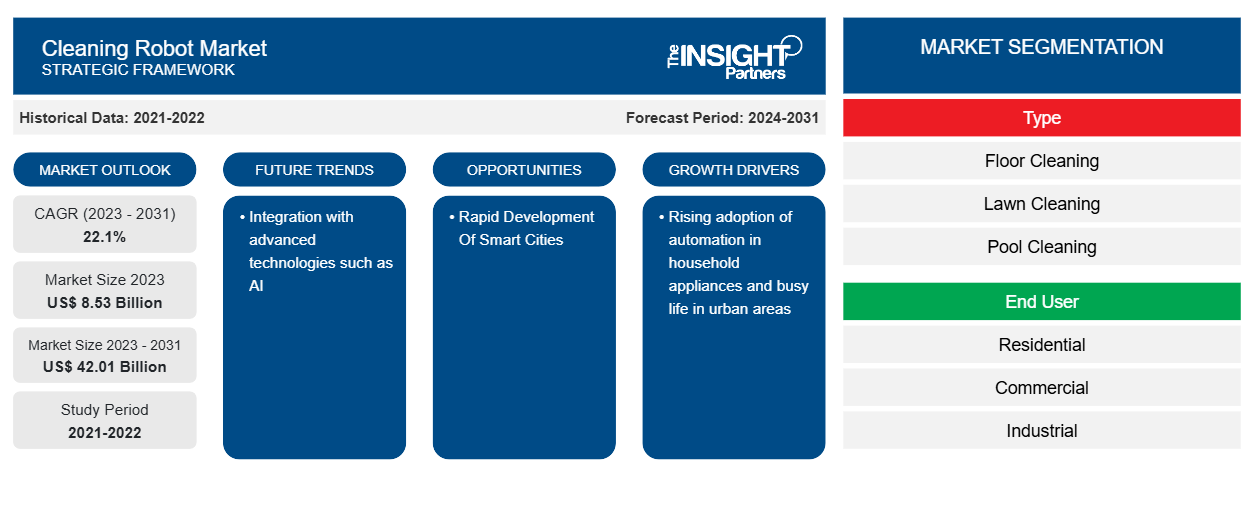清洁机器人市场规模预计将从 2023 年的 85.3 亿美元增长到 2031 年的 420.1 亿美元;预计 2023 年至 2031 年的复合年增长率为 22.1%。与人工智能等先进技术的融合可能仍是清洁机器人市场的一个关键趋势。
清洁机器人市场分析
由于各国城市化进程加快,城市就业竞争加剧,人们工作繁忙,没有时间投入清洁工作。此外,发达国家和发展中国家的清洁工雇佣成本高昂。因此,人们越来越倾向于自动化清洁。此外,清洁机器人的应用正在扩展到其他垂直行业,如医疗保健、汽车、物流等。因此,市场参与者正在推出新产品,以满足工业和住宅应用对清洁机器人日益增长的需求。例如,2021 年 9 月,由于物联网 (IoT) 和家庭技术领域的快速发展,Realme 推出了 Realme Techlife 手持式吸尘器、机器人吸尘拖把和空气净化器。
此外,紧凑的尺寸和适合较小空间的能力有助于清洁机器人清洁人类无法清洁的区域。此外,它还可以在人类触及可能致命的危险环境中使用。因此,这些功能和产品发布推动了 清洁机器人市场的发展
人们越来越关注 智能家居设备,以获得便捷的生活体验,这是推动机器人在住宅应用中应用的主要因素,并进一步推动了清洁机器人市场的发展。这些机器人提供了高度的便利,因为它们允许房主自主地在房子里移动,清洁地板、地毯和其他表面,而无需他们不断观察。此外,清洁是一项耗时的家务,随着生活方式的快速变化、繁忙的日程安排和可支配收入的增加,清洁机器人在住宅空间中的采用率越来越高,预计将在未来几年推动清洁机器人市场的发展。
清洁机器人市场概况
清洁机器人用于住宅、商业和工业等多种终端用户应用的清洁目的。这些类型的机器人用于多种应用,例如地板清洁、泳池清洁、草坪清洁、窗户清洁,以及垃圾清洁、排水沟清洁等其他应用。此外,不同行业和终端用户对自动化的广泛采用正在催化清洁机器人市场,预计未来几年将经历快速增长。清洁机器人是自主机器,可以自行执行清洁活动,并且始终无需任何人工干预、观察或控制。这些机器人具有各种功能和技术,使它们能够执行自动驾驶模式并自动清洁。唯一需要的人工助手是设置启动清洁过程的时间。这些功能推动了清洁机器人市场的发展。
定制此报告以满足您的需求
您可以免费定制任何报告,包括本报告的部分内容、国家级分析、Excel 数据包,以及为初创企业和大学提供优惠和折扣
- 获取此报告的关键市场趋势。这个免费样品将包括数据分析,从市场趋势到估计和预测。
清洁机器人市场驱动因素和机遇
家用电器自动化程度不断提高,有利于市场增长
由于一些国家经济的增长,城市化和人口的可支配收入也在增加。随着技术的进步,人们正在采用家庭自动化解决方案,例如支持家庭中使用的每台电子设备的自动化和控制的智能家居,并且可以从世界任何地方进行远程控制。清洁机器人用于各种目的,例如紫外线消毒、拖地和许多其他家庭活动。为了满足这种需求,清洁机器人市场参与者推出了产品。例如,2021 年 1 月,总部位于韩国的 ZetaBank 推出了一系列新的自主移动消毒机器人。在发达国家,劳动力成本的上升是人口越来越倾向于自动化的关键因素。对于残疾人和老年人口来说,清洁机器人是昂贵家务活动的替代品。因此,所有提到的因素都支持清洁机器人市场的增长。
智慧城市快速发展 清洁机器人市场迎来机遇
随着许多发达国家和发展中国家智能城市的快速发展,各种日常活动的自动化程度正在提高。智能建筑的发展意味着大多数任务的自动化,并通过中央单元进行控制。此外,随着城市人口可支配收入的增加,人们正转向家庭各个方面的自动化,如电力、清洁等。随着城市化进程的加快,城市居民的生活日程繁忙而紧张,他们没有太多时间进行清洁。此外,清洁活动对劳动力的依赖也增加了盗窃风险。因此,许多人开始采用机器人来清洁房屋,以确保房屋的每个角落都能得到安全、妥善的清洁。
清洁机器人市场报告细分分析
有助于得出清洁机器人市场分析的关键部分是类型和最终用户。
- 根据类型,清洁机器人市场分为地板清洁、草坪清洁、泳池清洁和窗户清洁。
- 根据最终用户,清洁机器人市场分为住宅、商业和工业。
清洁机器人市场份额按地区分析
- 清洁机器人市场分为五大区域:北美、欧洲、亚太地区 (APAC)、中东和非洲 (MEA) 以及南美和中美。2023 年,亚太地区占据市场主导地位。
- 亚洲国家经济强劲增长意味着人均消费能力增强。多年来,该地区最突出的国家,包括中国、印度、日本、新加坡、韩国、马来西亚和越南,都见证了经济增长,这有助于民众采用先进技术,推动清洁机器人在住宅、商业和工业应用中的采用,并推动亚太地区清洁机器人市场份额的增长。
- 亚太地区是全球机器人普及趋势的前沿;最近发现,亚太地区的消费者越来越喜欢自动化家庭活动,这主要是由于城市化进程的大幅增长和忙碌的生活方式。预计在预测期内,这些家用服务机器人的使用增加将大大促进清洁机器人市场的增长。
清洁机器人市场区域洞察
Insight Partners 的分析师已详细解释了预测期内影响清洁机器人市场的区域趋势和因素。本节还讨论了北美、欧洲、亚太地区、中东和非洲以及南美和中美洲的清洁机器人市场细分和地理位置。

- 获取清洁机器人市场的区域特定数据
清洁机器人市场报告范围
| 报告属性 | 细节 |
|---|---|
| 2023 年的市场规模 | 85.3亿美元 |
| 2031 年市场规模 | 420.1亿美元 |
| 全球复合年增长率(2023 - 2031) | 22.1% |
| 史料 | 2021-2022 |
| 预测期 | 2024-2031 |
| 涵盖的领域 | 按类型
|
| 覆盖地区和国家 | 北美
|
| 市场领导者和主要公司简介 |
|
清洁机器人市场参与者密度:了解其对业务动态的影响
清洁机器人市场正在快速增长,这得益于终端用户需求的不断增长,而这些需求又源于消费者偏好的不断变化、技术进步以及对产品优势的认识不断提高等因素。随着需求的增加,企业正在扩大其产品范围,进行创新以满足消费者的需求,并利用新兴趋势,从而进一步推动市场增长。
市场参与者密度是指在特定市场或行业内运营的企业或公司的分布情况。它表明在给定市场空间中,相对于其规模或总市场价值,有多少竞争对手(市场参与者)存在。
在清洁机器人市场运营的主要公司有:
- 阿尔弗雷德·凯驰有限公司
- 戴森有限公司
- 科沃斯机器人公司
- TASKI 智能机器人
- iRobot 公司
- LG 电子公司
免责声明:上面列出的公司没有按照任何特定顺序排列。

- 了解清洁机器人市场主要参与者概况
清洁机器人市场新闻和最新发展
通过收集一手和二手资料后获得的定性和定量数据来评估点对点保险市场,其中包括重要的公司出版物、协会数据和数据库。以下是清洁机器人市场的发展列表:
- 2022 年 5 月,海尔推出了其首款智能吸尘器技术,即二合一干湿拖把机器人吸尘器。这款吸尘器配备 2.4 GHz Wi-Fi 和 Google Home Assistant,并通过海尔智能应用、语音控制和遥控器提供智能管理。(来源:海尔,新闻稿)
- 2022 年 10 月,ECOVACS 推出了新的智能机器人产品,包括机器人割草机 GOAT G1 和联网商用地板清洁机器人 DEEBOT PRO。机器人割草机 GOAT G1 可以在不到 30 分钟的时间内绘制草坪及其边界图,从而实现高效的草坪清洁。DEEBOT 专为购物中心、办公楼、酒店和其他大型场所而设计。(来源:ECOVACS,新闻稿)
清洁机器人市场报告范围和交付成果
“清洁机器人市场规模和预测(2021-2031)”对以下领域进行了详细的市场分析:
- 范围内涵盖的所有主要细分市场的全球、区域和国家层面的市场规模和预测
- 市场动态,如驱动因素、限制因素和关键机遇
- 未来主要趋势
- 详细的 PEST/波特五力分析和 SWOT 分析
- 全球和区域市场分析涵盖关键市场趋势、主要参与者、法规和最新市场发展
- 行业格局和竞争分析,涵盖市场集中度、热点图分析、知名参与者和最新发展
- 详细的公司简介
- 历史分析(2 年)、基准年、预测(7 年)及复合年增长率
- PEST 和 SWOT 分析
- 市场规模价值/数量 - 全球、区域、国家
- 行业和竞争格局
- Excel 数据集



Report Coverage
Revenue forecast, Company Analysis, Industry landscape, Growth factors, and Trends

Segment Covered
This text is related
to segments covered.

Regional Scope
North America, Europe, Asia Pacific, Middle East & Africa, South & Central America

Country Scope
This text is related
to country scope.
常见问题
Asia Pacific is expected to hold the highest market share in the cleaning robot market.
The key players holding majority shares in the global cleaning robot market areKoninklijke Philips N.V.; Ecovacs Robotics, Inc.; iRobot Corporation; LG Electronics Inc.; and Neato Robotics, Inc.
Integration with advanced technologies such as AI is anticipated to play a significant role in the global cleaning robot market in the coming years.
Rising adoption of automation in household appliances and busy life in urban areas are the major factors driving the cleaning robot market.
The global cleaning robot market was estimated to be US$ 8.53 billion in 2023 and is expected to grow at a CAGR of 22.1% during the forecast period 2024 - 2031.
Trends and growth analysis reports related to Electronics and Semiconductor : READ MORE..
The Insight Partners performs research in 4 major stages: Data Collection & Secondary Research, Primary Research, Data Analysis and Data Triangulation & Final Review.
- Data Collection and Secondary Research:
As a market research and consulting firm operating from a decade, we have published and advised several client across the globe. First step for any study will start with an assessment of currently available data and insights from existing reports. Further, historical and current market information is collected from Investor Presentations, Annual Reports, SEC Filings, etc., and other information related to company’s performance and market positioning are gathered from Paid Databases (Factiva, Hoovers, and Reuters) and various other publications available in public domain.
Several associations trade associates, technical forums, institutes, societies and organization are accessed to gain technical as well as market related insights through their publications such as research papers, blogs and press releases related to the studies are referred to get cues about the market. Further, white papers, journals, magazines, and other news articles published in last 3 years are scrutinized and analyzed to understand the current market trends.
- Primary Research:
The primarily interview analysis comprise of data obtained from industry participants interview and answers to survey questions gathered by in-house primary team.
For primary research, interviews are conducted with industry experts/CEOs/Marketing Managers/VPs/Subject Matter Experts from both demand and supply side to get a 360-degree view of the market. The primary team conducts several interviews based on the complexity of the markets to understand the various market trends and dynamics which makes research more credible and precise.
A typical research interview fulfils the following functions:
- Provides first-hand information on the market size, market trends, growth trends, competitive landscape, and outlook
- Validates and strengthens in-house secondary research findings
- Develops the analysis team’s expertise and market understanding
Primary research involves email interactions and telephone interviews for each market, category, segment, and sub-segment across geographies. The participants who typically take part in such a process include, but are not limited to:
- Industry participants: VPs, business development managers, market intelligence managers and national sales managers
- Outside experts: Valuation experts, research analysts and key opinion leaders specializing in the electronics and semiconductor industry.
Below is the breakup of our primary respondents by company, designation, and region:

Once we receive the confirmation from primary research sources or primary respondents, we finalize the base year market estimation and forecast the data as per the macroeconomic and microeconomic factors assessed during data collection.
- Data Analysis:
Once data is validated through both secondary as well as primary respondents, we finalize the market estimations by hypothesis formulation and factor analysis at regional and country level.
- Macro-Economic Factor Analysis:
We analyse macroeconomic indicators such the gross domestic product (GDP), increase in the demand for goods and services across industries, technological advancement, regional economic growth, governmental policies, the influence of COVID-19, PEST analysis, and other aspects. This analysis aids in setting benchmarks for various nations/regions and approximating market splits. Additionally, the general trend of the aforementioned components aid in determining the market's development possibilities.
- Country Level Data:
Various factors that are especially aligned to the country are taken into account to determine the market size for a certain area and country, including the presence of vendors, such as headquarters and offices, the country's GDP, demand patterns, and industry growth. To comprehend the market dynamics for the nation, a number of growth variables, inhibitors, application areas, and current market trends are researched. The aforementioned elements aid in determining the country's overall market's growth potential.
- Company Profile:
The “Table of Contents” is formulated by listing and analyzing more than 25 - 30 companies operating in the market ecosystem across geographies. However, we profile only 10 companies as a standard practice in our syndicate reports. These 10 companies comprise leading, emerging, and regional players. Nonetheless, our analysis is not restricted to the 10 listed companies, we also analyze other companies present in the market to develop a holistic view and understand the prevailing trends. The “Company Profiles” section in the report covers key facts, business description, products & services, financial information, SWOT analysis, and key developments. The financial information presented is extracted from the annual reports and official documents of the publicly listed companies. Upon collecting the information for the sections of respective companies, we verify them via various primary sources and then compile the data in respective company profiles. The company level information helps us in deriving the base number as well as in forecasting the market size.
- Developing Base Number:
Aggregation of sales statistics (2020-2022) and macro-economic factor, and other secondary and primary research insights are utilized to arrive at base number and related market shares for 2022. The data gaps are identified in this step and relevant market data is analyzed, collected from paid primary interviews or databases. On finalizing the base year market size, forecasts are developed on the basis of macro-economic, industry and market growth factors and company level analysis.
- Data Triangulation and Final Review:
The market findings and base year market size calculations are validated from supply as well as demand side. Demand side validations are based on macro-economic factor analysis and benchmarks for respective regions and countries. In case of supply side validations, revenues of major companies are estimated (in case not available) based on industry benchmark, approximate number of employees, product portfolio, and primary interviews revenues are gathered. Further revenue from target product/service segment is assessed to avoid overshooting of market statistics. In case of heavy deviations between supply and demand side values, all thes steps are repeated to achieve synchronization.
We follow an iterative model, wherein we share our research findings with Subject Matter Experts (SME’s) and Key Opinion Leaders (KOLs) until consensus view of the market is not formulated – this model negates any drastic deviation in the opinions of experts. Only validated and universally acceptable research findings are quoted in our reports.
We have important check points that we use to validate our research findings – which we call – data triangulation, where we validate the information, we generate from secondary sources with primary interviews and then we re-validate with our internal data bases and Subject matter experts. This comprehensive model enables us to deliver high quality, reliable data in shortest possible time.


 获取此报告的免费样本
获取此报告的免费样本